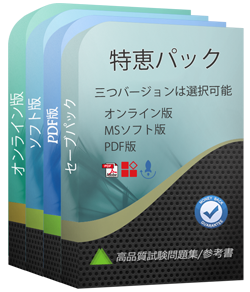無料デモをごダウンロードいただけます
様々な復習資料が市場に出ていることから、多くの候補者は、どの資料が適切かを知りません。この状況を考慮に入れて、私たちはMicrosoft 70-516の無料ダウンロードデモを候補者に提供します。弊社のウェブサイトにアクセスしてTS: Accessing Data with Microsoft .NET Framework 4デモをダウンロードするだけで、70-516試験復習問題を購入するかどうかを判断するのに役立ちます。多数の新旧の顧客の訪問が当社の能力を証明しています。私たちの70-516試験の学習教材は、私たちの市場におけるファーストクラスのものであり、あなたにとっても良い選択だと確信しています。
Tech4Examはどんな学習資料を提供していますか?
現代技術は人々の生活と働きの仕方を革新します(70-516試験学習資料)。 広く普及しているオンラインシステムとプラットフォームは最近の現象となり、IT業界は最も見通しがある業界(70-516試験認定)となっています。 企業や機関では、候補者に優れた教育の背景が必要であるという事実にもかかわらず、プロフェッショナル認定のようなその他の要件があります。それを考慮すると、適切なMicrosoft TS: Accessing Data with Microsoft .NET Framework 4試験認定は候補者が高給と昇進を得られるのを助けます。
70-516試験学習資料を開発する専業チーム
私たちは70-516試験認定分野でよく知られる会社として、プロのチームにTS: Accessing Data with Microsoft .NET Framework 4試験復習問題の研究と開発に専念する多くの専門家があります。したがって、我々のMCTS試験学習資料が70-516試験の一流復習資料であることを保証することができます。私たちは、MCTS 70-516試験サンプル問題の研究に約10年間集中して、候補者が70-516試験に合格するという目標を決して変更しません。私たちの70-516試験学習資料の質は、Microsoft専門家の努力によって保証されています。それで、あなたは弊社を信じて、我々のTS: Accessing Data with Microsoft .NET Framework 4最新テスト問題集を選んでいます。
TS: Accessing Data with Microsoft .NET Framework 4試験学習資料での高い復習効率
ほとんどの候補者にとって、特にオフィスワーカー、70-516試験の準備は、多くの時間とエネルギーを必要とする難しい作業です。だから、適切な70-516試験資料を選択することは、70-516試験にうまく合格するのに重要です。高い正確率がある70-516有効学習資料によって、候補者はTS: Accessing Data with Microsoft .NET Framework 4試験のキーポイントを捉え、試験の内容を熟知します。あなたは約2日の時間をかけて我々の70-516試験学習資料を練習し、70-516試験に簡単でパスします。
70-516試験認定を取られるメリット
ほとんどの企業では従業員が専門試験の認定資格を取得する必要があるため、70-516試験の認定資格がどれほど重要であるかわかります。テストに合格すれば、昇進のチャンスとより高い給料を得ることができます。あなたのプロフェッショナルな能力が権威によって認められると、それはあなたが急速に発展している情報技術に優れていることを意味し、上司や大学から注目を受けます。より明るい未来とより良い生活のために私たちの信頼性の高い70-516最新試験問題集を選択しましょう。
Microsoft TS: Accessing Data with Microsoft .NET Framework 4 認定 70-516 試験問題:
1. You use Microsoft Visual Studio 2010 and Microsoft .NET Framework 4.0 to develop an application.
You use the ADO.NET Entity Framework Designer to model entities. The model contains an entity type
named Product.
You need to ensure that a stored procedure will be invoked when the ObjectContext.SaveChanges method
is executed after an attached Product has changed.
What should you do in the ADO.NET Entity Framework Designer?
A) Add a stored procedure mapping for the Product entity type.
B) Add a function import for the Product entity type.
C) Add a complex type named Product that is mapped to the stored procedure.
D) Add a new entity that has a base class of Product that is mapped to the stored procedure.
2. You use Microsoft Visual Studio 2010 and Microsoft .NET Framework 4.0 to create an application. You use the ADO.NET Entity Framework to model entities. You write the following code segment. (Line numbers are included for reference only.)
01 public partial class SalesOrderDetail : EntityObject
02 {
03 partial void OnOrderQtyChanging(short value)
04 {
05 ...
06 {
07 ...
08 }
09 }
10 }
You need to find out whether the object has a valid ObjectStateEntry instance. Which code segment should you insert at line 05?
A) if (this.EntityState != EntityState.Detached)
B) if (this.EntityState != EntityState.Unchanged)
C) if (this.EntityState != EntityState.Added)
D) if (this.EntityState != EntityState.Modified)
3. You use Microsoft Visual Studio 2010 and Microsoft .NET Framework 4.0 to develop an application that
uses the Entity Framework.
You create the following Entity Data Model.
You add the following code fragment:
using(var context = new AdventureWorksLTEntities())
{ Customer cust = context.Customers.First(); cust.CompanyName = "Contoso"; int count = 0;
}
The changes to the cust entity must be saved. If an exception is thrown, the application will attempt to save
up to 3 times.
If not, an exception is thrown. Which code segment should you use?
A) while(count++ < 3)
{
try
{
context.SaveChanges();
break;
}
catch(Exception)
{
}
}
B) while(true)
{ context.SavingChanges += delegate(System.Object o, System.EventArgs e) {
if(count++ >2)
{
throw new Exception();
}
context.SaveChanges();
}
}
C) while(context.ObjextStateManager.GetObjectStateEntry (cust).OriginalValues.IsDBNull(0)) {
if(count++ >2)
{
break;
}
context.SaveChanges();
}
D) while(cust.EntityState == EntityState.Modified)
{
try
{
context.SaveChanges();
}
catch(Exception)
{
if(count++ > 2 && context.Connection.State ==
ConnectionState.Broken
{
throw new Exception();
}
}
}
4. You use Microsoft .NET Framework 4.0 to develop an application that connects to two separate Microsoft
SQL Server 2008 databases.
The Customers database stores all the customer information, and the Orders database stores all the order
information.
The application includes the following code. (Line numbers are included for reference only.)
01 try
02 {
03 conn.Open();
04 tran = conn.BeginTransaction("Order");
05 SqlCommand cmd = new SqlCommand();
06 cmd.Connection = conn;
07 cmd.Transaction = tran;
08 tran.Save("save1");
09 cmd.CommandText = "INSERT INTO [Cust].dbo.Customer " + "(Name,
PhoneNumber) VALUES ('Paul Jones', " + "'404-555-1212')";
10 cmd.ExecuteNonQuery();
11 tran.Save("save2");
12 cmd.CommandText = "INSERT INTO [Orders].dbo.Order " + "(CustomerID)
VALUES (1234)";
13 cmd.ExecuteNonQuery();
14 tran.Save("save3");
15 cmd.CommandText = "INSERT INTO [Orders].dbo." + "OrderDetail (OrderlD,
ProductNumber) VALUES" + "(5678, 'DC-6721')";
16 cmd.ExecuteNonQuery();
17 tran.Commit();
18 }
19 catch (Exception ex)
20 {
21 ...
22 }
You run the program, and a timeout expired error occurs at line 16. You need to ensure that the customer
information is saved in the database.
If an error occurs while the order is being saved, you must roll back all of the order information and save the
customer information.
Which line of code should you insert at line 21?
A) tran.Rollback(); tran.Commit();
B) tran.Rollback("save2");
C) tran.Rollback("save2"); tran.Commit();
D) tran.Rollback();
5. You use Microsoft Visual Studio 2010 and Microsoft .NET Framework 4.0 to create an application.
The application connects to a Microsoft SQL Server database.
The application has two DataTable objects that reference the Customers and Orders tables in the
database.
The application contains the following code segment. (Line numbers are included for reference only.)
01 DataSet customerOrders = new DataSet();
02 customerOrders.EnforceConstraints = true;
03 ForeignKeyConstraint ordersFK = new ForeignKeyConstraint("ordersFK",
04 customerOrders.Tables
["Customers"].Columns["CustomerID"],
05 customerOrders.Tables["Orders"].Columns
["CustomerID"]);
06 ...
07 customerOrders.Tables["Orders"].Constraints.Add(ordersFK);
You need to ensure that an exception is thrown when you attempt to delete Customer records that have related Order records.
Which code segment should you insert at line 06?
A) ordersFK.DeleteRule = Rule.SetDefault;
B) ordersFK.DeleteRule = Rule.None;
C) ordersFK.DeleteRule = Rule.Cascade;
D) ordersFK.DeleteRule = Rule.SetNull;
質問と回答:
| 質問 # 1 正解: A | 質問 # 2 正解: C | 質問 # 3 正解: D | 質問 # 4 正解: C | 質問 # 5 正解: B |


 弊社は製品に自信を持っており、面倒な製品を提供していません。
弊社は製品に自信を持っており、面倒な製品を提供していません。


 山口**
山口**


